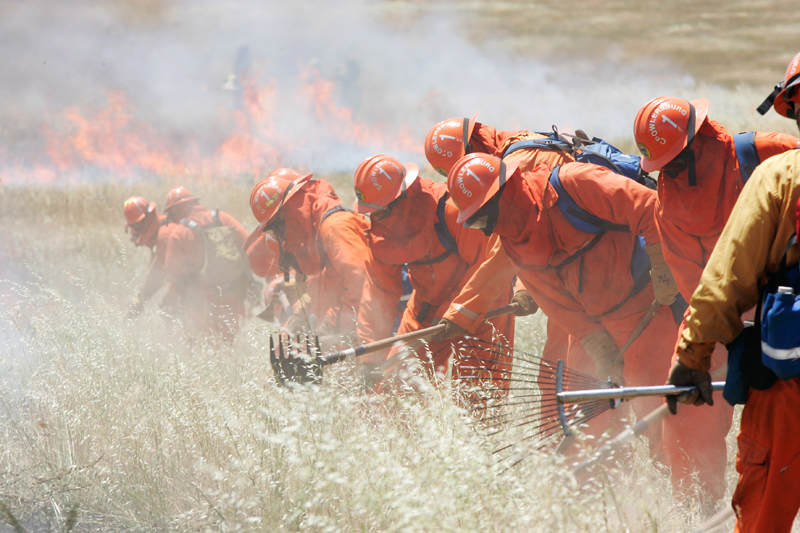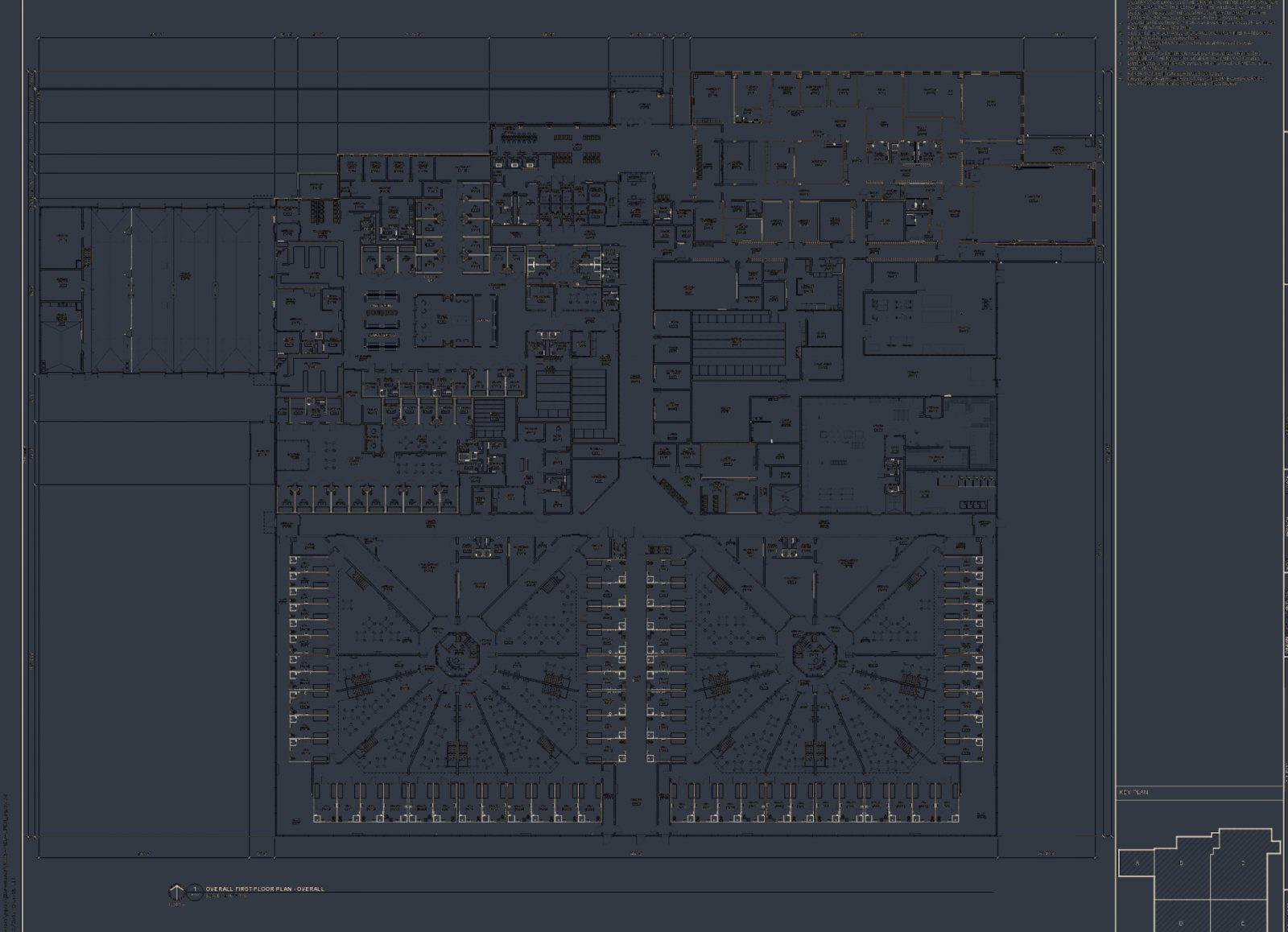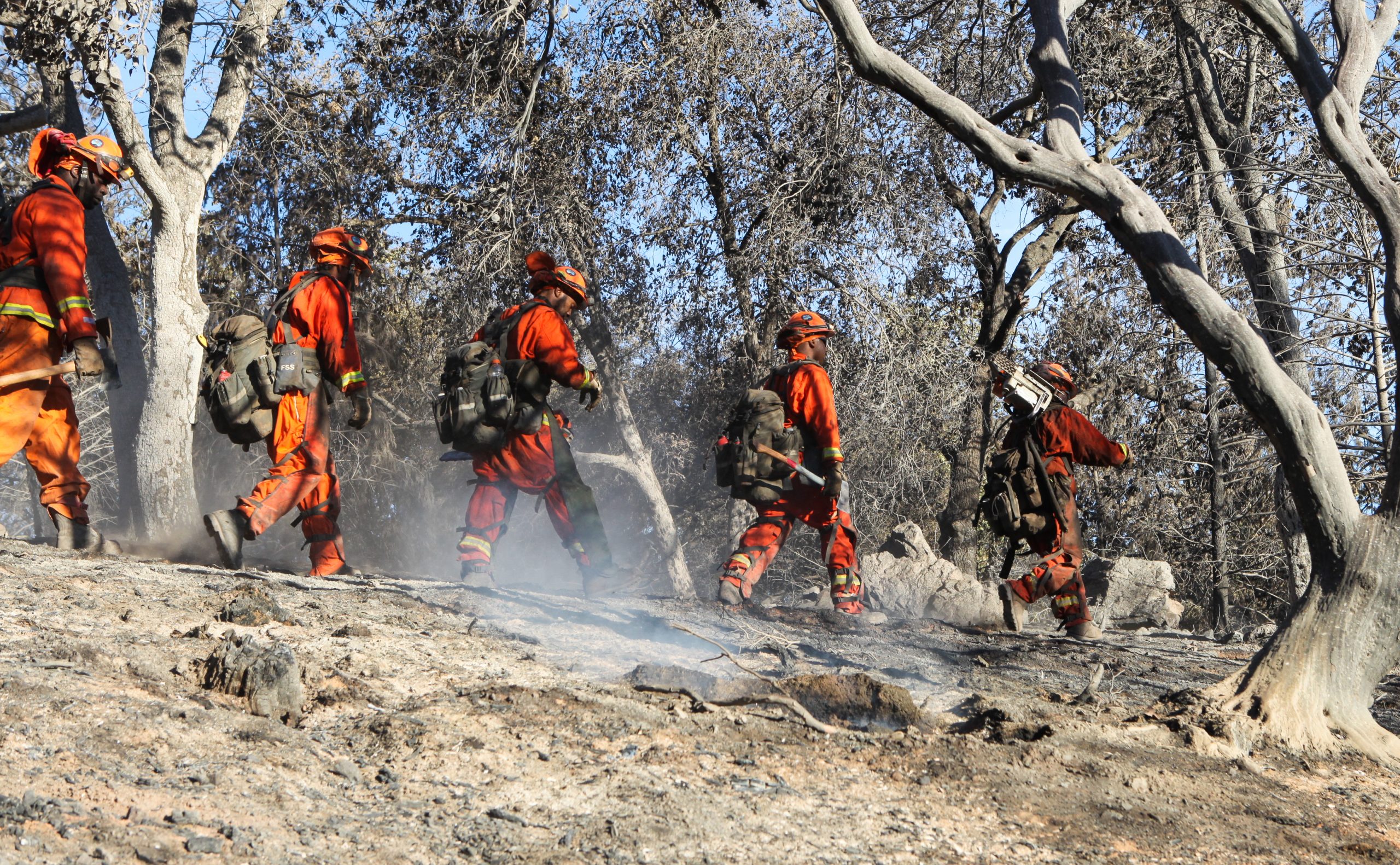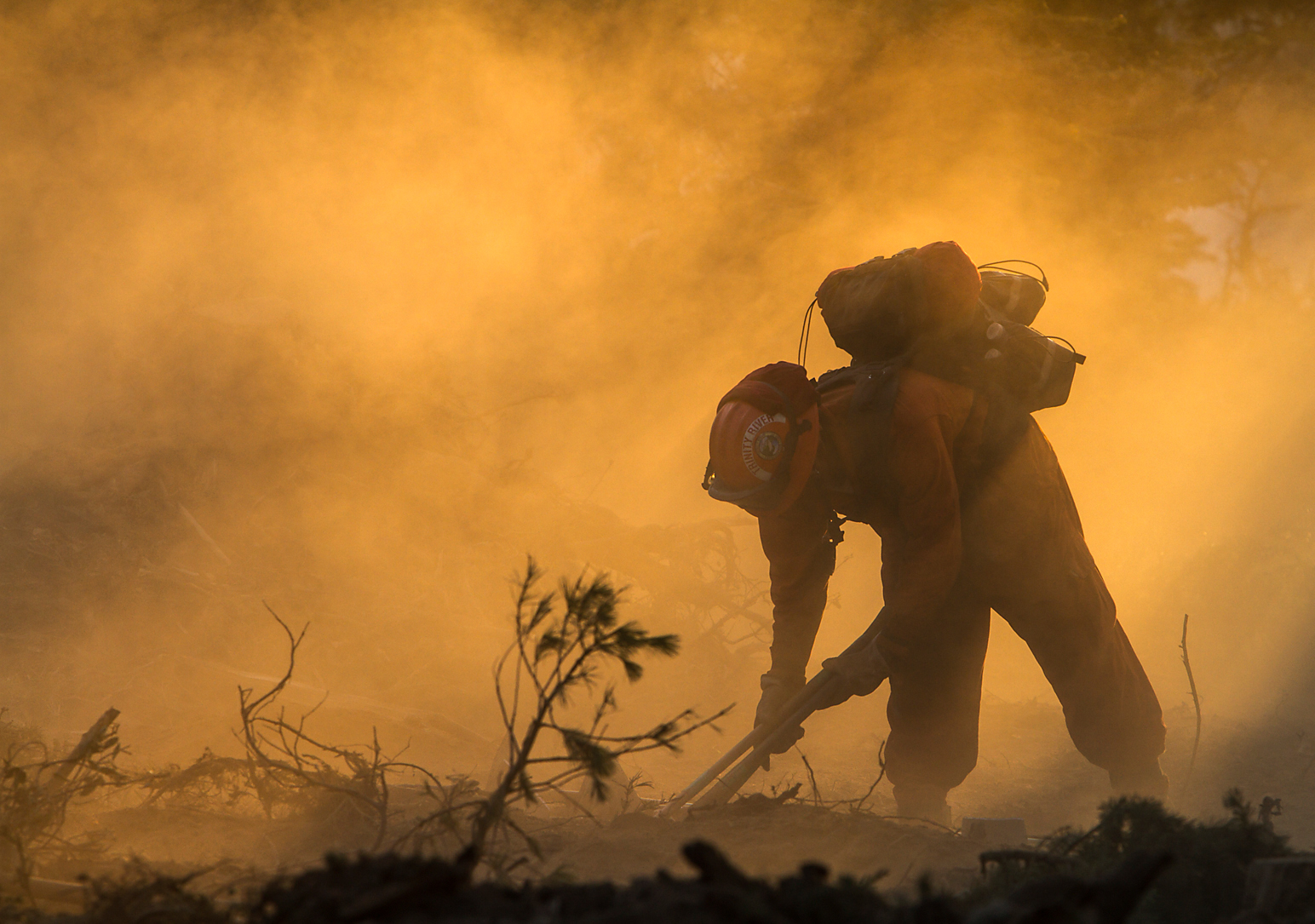What makes a prison a prison?
Is it a particular style of building? Or how that building is used? Is it that the people are forced to be there? These questions might sound abstract, but not all people remanded to state custody are necessarily kept in traditional prison facilities. Take, for example, California’s conservation camps—commonly dubbed “fire camps”—where incarcerated Californians are made to do the dangerous work of fighting wildfires. These camps operate outside of prison walls, replacing concrete cells and barbed wire with wild greenery and open air.
So, are the people there still in prison?
Advocates of the camps, including some of the people incarcerated in them, say that the camps represent a huge improvement over the crowded and dangerous conditions of California’s prisons. Taking that assessment at face value, I hope to demonstrate, nevertheless, that fire camps are still prisons, even without bars and walls. A prison, in other words, is not only about how space is constructed, but also about relationships of power and the phantasmic influence those relationships have on incarcerated people.
First established in 1915 and expanded during World War II, the Conservation Camp Program (or CCP) has long been essential to managing California’s wildfire woes. The professedly voluntary program is managed by two state departments—the California Department of Corrections and Rehabilitation (CDCR) and the California Department of Forestry and Fire Protection (CAL FIRE)—which together oversee the selection, training, and employment of incarcerated people to perform public works throughout the state. The primary service provided by the thirty-five camps, including two dedicated for incarcerated women and one for incarcerated youth, is wildlands firefighting, inspiring their commonly adopted moniker: fire camps. These camps, housing some 1,700 incarcerated workers, have come to play an outsize role in the state’s wildfire mitigation efforts. Spanning twenty-five counties, they accounted for as much as 30 percent of the state’s wildlands firefighting force in 2017, and continue to supply millions of human-hours in labor every year.

Much about life within the fire camps belies our stereotype of what a prison looks like. Sociologist Philip Goodman writes that walled prisons in California “have massive electrified fences[,] are staffed by hundreds of officers and staff[,] and are often barren, concrete, and drab.” In stark contrast, the fire camps have no concrete cells or barbed wire, no armed guards or tall barriers. Instead, Goodman continues, in the camps “concrete is replaced with greenery and attractive landscaping[,] electrified fences with small wooden signs reading ‘camp boundary[,]’ and infamously bad prison food with comparatively tasty and wholesome meals.” CAL FIRE staff, occasionally supplemented by CDCR, is primarily responsible for supervising and training camp workers, meaning civilian firefighters and administrators assume roles otherwise reserved for prison guards and wardens.

From the Series
Carceral Geographies
Essays exploring how mass incarceration shapes, and is shaped by, our shared world and built spaces.
Other differences transcend the aesthetic. Incarcerated workers who volunteer for the camps are in many ways treated like workers first, and incarcerated people second. According to Goodman, incarcerated firefighters “have almost complete freedom of movement, provided they stay within camp boundaries and provided they report to work on time and prepared to work.” Ordinary means of prison discipline, including bouts of prolonged solitary confinement or other efforts to remove human contact, are replaced mainly with a singular threat: that troublemakers could be sent back to a walled prison. Moreover, the racial dynamics in the camps differ markedly from those found within walled prisons. Notwithstanding the de facto racial segregation present throughout California’s prison system, incarcerated firefighters are expected to support one another, no matter their identity. As Goodman writes: “Prisoners are putting their lives in the hands of their crewmates, including those who . . . belong[] to diverse ethnoracial groups.” After all, fire does not discriminate, nor does it care about one’s incarceration status.
Several camp veterans have been outspoken supporters of the CCP, contending that the program represents the best among a limited set of options for those incarcerated in the Golden State. Matthew Hahn, writing in the Washington Post, observes that in his “nine years in prison,” he “never met a fellow prisoner who didn’t want to be in ‘fire camp’”; that “some dreamed of going but knew they would never be allowed to live in such a low-security facility,” and “others . . . did everything in their capacity to ensure that they got there as soon as humanly possible.” Aside from the camps’ conditions, other veterans cite the nature of the work as a potent lure. Joshua Daniel Bligh writes that in the fire camps, he discovered things inside himself that he didn’t know he possessed, and that “the greatest joy [was] the chance to be appreciated, to feel normal for a week or two.” Hahn, similarly, found “satisfaction in knowing that my work was as valuable as that of any other firefighter.”
There is truth to these accounts, as the camps counteract some of the ways in which prisons dehumanize and degrade the people who enter them. Imprisonment has been described as an act of disappearance, in which individual identity is lost and transformed by the harsh conditions of the prison environment. The fire camps, conversely, place incarcerated workers in a position of relative veneration: the role of a first responder. For Bligh, the change was noticeable, and was reflected in the treatment incarcerated firefighters received from their civilian counterparts: “We were dressed the same. . . . We lived at fire camp with the civilian and government crews. We worked side-by-side with them on the fire line. . . . We ate the same food, under the same tent. In a sense, we were the same.”
However, despite some of the ways in which fire camps break the prison mold, they are not as disruptive of the prison paradigm as one might think. Appearances aside, fire camps are still prison spaces. The fire camps operate through common carceral logic, in which coercive power dynamics—given life by the looming specter of a return to deprivation and struggle—shape the experiences of those who work in them.
Perhaps most obviously, and notwithstanding the composition of the staff, fire camps retain two core features of prison life: surveillance and punishment. Goodman concedes that the camps are not lush wilderness retreats, but instead “resemble well-kept army outposts,” in which there is “considerable (if sporadic) surveillance by officers.” And even absent cells dedicated to solitary confinement, camp staff still respond to “infractions” with “significant punishments,” including for the supposedly “egregious” violation of refusing to work.
Decarceral thinkers and doers
Every week, Inquest aims to bring you insights from people thinking through and working for a world without mass incarceration.
Sign up for our newsletter for the latest.
Newsletter
But what is more telling is the nature of the fire camps’ work. The labor expected of those within the camps resembles much of the work found within walled prisons, in that it is dangerous, monotonous, and undercompensated.
Begin with the danger. Work on the fire line is physically arduous, and consists of using power tools to contain wildfires by building fuel breaks. This is accomplished by clearing out smoldering embers, churning freshly burned soil, and ripping out cindered tree stumps to deprive wildfires of the fuel they need to spread. Though not immediately exposed to the blaze, incarcerated workers face real peril in their work. One investigation found that “1,000 inmate firefighters required hospital care between June 2013 and August 2018,” and incarcerated firefighters are “more than four times as likely, per capita, to incur object-induced injuries” compared to civilian firefighters. They are also “eight times as likely to be injured after inhaling smoke and particulates.” The dangerous nature of the work has, at times, even caught the attention of the courts, including those outside of California. In one recent filing, incarcerated firefighters in Nevada claimed the state supplied them with overworn boots, which practically melted off their feet when exposed to the heat of wildfires.
When not actively endangered on the fire line, camp veterans are subjected to more ordinary and monotonous forms of physical labor. Camp workers are often loaned out to local communities to supply cheap labor for other public works, many of which have little to do with preventing or stopping fires. Goodman describes these “grade projects” as involving menial and physically intensive work, such as “using sledgehammers to demolish stone grills at a local park, [and] landscaping and general maintenance at fire stations and public parks.” This hard manual labor performed at the behest of various local and state agencies ensures that at no point in their service (that is, even outside of wildfire season) are incarcerated firefighters devoid of work supplied by their jailers.
Finally, the work—like practically all prison work—is woefully undercompensated. For their service, and all the risks that accompany it, incarcerated firefighters earned between $2.90 and $5 a day in 2021, plus an additional $1–2 an hour when working on a fire line. This may be a higher rate than for other prison work, but it still fails to reflect the taxing and dangerous conditions incarcerated firefighters routinely experience. And of course, not all of this meager sum is retained; some 55 percent is garnished for restitution. To camp veterans such as Amika Mota, this was exploitation, pure and simple. And even camp proponent Bligh admits to finding insult in “the pathetic little money we were making risking our lives and working our fingers to the bone.”

The CCP promises other benefits besides monetary compensation, but they have proven to be thin. For instance, in 2016 California enacted Proposition 57, which provides time credit to incarcerated workers, shortening their sentences. For those eligible, every two days of service grant one day of credit. But in a justice system that already inflates prison sentences, this is a small comfort to those staring down long prison terms, especially considering that only lower-grade offenders are permitted to work in the camps.
Another nonmonetary incentive is elevated employment prospects. CDCR touts that camp graduates can earn civilian firefighting jobs upon release, finding work in CAL FIRE or even in municipal firehouses. But, as Mota describes, “despite my training, experience and the fact prison officials determined I was safe to help save lives in the community, I had no realistic path to the same work after I was released.” Camp veterans have historically faced significant employment barriers post-release, requiring them to navigate lengthy court processes to expunge their records before they can apply for requisite EMT licenses.
In short, fire camps offer perhaps a marginal improvement upon the ordinary work found in walled prisons, but are not nearly as groundbreaking as they appear to be. Contrary to the rosy picture the CCP paints, fire camp work bears all the hallmark features of ordinary prison labor.
But there is more that makes the fire camps genuine, albeit unconventional, prison spaces. Namely, it is the ominous and ubiquitous presence of power—the threat of harm in answer to disobedience. A closer read of Hahn’s account reveals important insights about the incentive structures surrounding the fire camps. As he describes it, the multitudes seeking to work in the camps are not motivated by a desire to serve, but rather a desire to escape: “The conditions in California prisons are so terrible that fighting wildfires is a rational choice.” For California’s incarcerated people, the persistent danger and deprivation found within walled prisons are simply worse than the acute hazards of fire, smoke, and tool-related injury presented by the camps.
Telling, then, that the CCP’s greatest punishment for one who refuses to work is sending them back to a walled prison. The threat looms large in the minds of camp workers. As Bligh remarks: “When I sense outrage and shock in the faces of the contract crews who hear how little we make for the work we do, I remember that I could have been sitting in a prison cell in the penitentiary. I think a lot of inmate firefighters feel the same way.”
Though Bligh couches this observation in the language of gratitude—that he worked hard because he was “given the opportunity”—others see these incentive structures in a more coercive light. Another camp veteran, Jacques D’Elia, explains that the specter of returning to a walled prison diminishes thoughts of disobedience: “You’re an inmate and you have to do what they say, scary as it is, or else you’re going to get sent back to prison.”
D’Elia’s account captures the coercion common to prison labor, which the ACLU describes as having three faces: “The threat of punishment—such as solitary confinement and loss of family visitation”; “deprivation—whereby incarcerated people work because it is the only way for them to pay for basic necessities”; and incentives, “such as the promise of earning ‘good time.’” The fire camps embody all three aspects of this definition. The possibility of being shipped back to a walled prison serves as threat of both punishment and deprivation, insofar as it represents being subjected to dangerous, toxic, and under-resourced facilities, and a return to cold concrete and dehumanizing treatment. The threat also features revocation of fire camp incentives, illusory as they may be: better pay, exposure to the outdoors, and job training.
One might think that the stark disparity between walled prisons and the fire camps serves to underscore the differences between them. If camp workers are afraid of walled prisons, does this not mean that fire camps are superior—perhaps so much so that we should not consider them to be prison spaces? We must listen carefully, however, to not miss that even by camp workers’ own accounts, fire camps remain prison spaces because the power dynamic essential to constructing prison space is present: the threat of force, wielded to ensure obedience and impose conditions of servitude on those within. Beneath the gilded veneer of the fire camps’ greenery is a phantom prison, which extracts dangerous, forced labor under the threat that, at any moment, a return to the perils and desperation of a walled prison could occur. Prison conditions, which people will risk life and limb fighting fires to avoid, are only removed superficially; they are still present, motivating workers’ conduct.
Participation in the CCP may well be a rational decision for California’s incarcerated people, but the mirage of free choice does not diminish the camps as sites of carceral coercion. Those working in the fire camps have not escaped the prison; they remain in an alternative prison space, wherein the prison has followed them outdoors. Each day it demands that they face the flames or return to a more familiar kind of suffering.
The U.S. prison has a salient yet intangible component: power born from fear. So imposing are the conditions of the modern prison that, even when all its outward features are stripped away, its presence still commands the actions of those dwelling within its shadow. For those who see the fire camps as heralding a newer, more humane brand of prison, the camps’ coercion should demand reorientation. To elevate the camps as a blueprint is not to “fix” the U.S. prison, but to transmute its phantom reach.
Header image: A fire camp firefighter at work. (Courtesy of the California Department of Corrections and Rehabilitation.)

